Fang He
Minkowski-MambaNet: A Point Cloud Framework with Selective State Space Models for Forest Biomass Quantification
Oct 10, 2025Abstract:Accurate forest biomass quantification is vital for carbon cycle monitoring. While airborne LiDAR excels at capturing 3D forest structure, directly estimating woody volume and Aboveground Biomass (AGB) from point clouds is challenging due to difficulties in modeling long-range dependencies needed to distinguish trees.We propose Minkowski-MambaNet, a novel deep learning framework that directly estimates volume and AGB from raw LiDAR. Its key innovation is integrating the Mamba model's Selective State Space Model (SSM) into a Minkowski network, enabling effective encoding of global context and long-range dependencies for improved tree differentiation. Skip connections are incorporated to enhance features and accelerate convergence.Evaluated on Danish National Forest Inventory LiDAR data, Minkowski-MambaNet significantly outperforms state-of-the-art methods, providing more accurate and robust estimates. Crucially, it requires no Digital Terrain Model (DTM) and is robust to boundary artifacts. This work offers a powerful tool for large-scale forest biomass analysis, advancing LiDAR-based forest inventories.
A Policy-Improved Deep Deterministic Policy Gradient Framework for the Discount Order Acceptance Strategy of Ride-hailing Drivers
Jul 16, 2025Abstract:The rapid expansion of platform integration has emerged as an effective solution to mitigate market fragmentation by consolidating multiple ride-hailing platforms into a single application. To address heterogeneous passenger preferences, third-party integrators provide Discount Express service delivered by express drivers at lower trip fares. For the individual platform, encouraging broader participation of drivers in Discount Express services has the potential to expand the accessible demand pool and improve matching efficiency, but often at the cost of reduced profit margins. This study aims to dynamically manage drivers' acceptance of Discount Express from the perspective of individual platforms. The lack of historical data under the new business model necessitates online learning. However, early-stage exploration through trial and error can be costly in practice, highlighting the need for reliable early-stage performance in real-world deployment. To address these challenges, this study formulates the decision regarding the proportion of drivers' acceptance behavior as a continuous control task. In response to the high stochasticity, the opaque matching mechanisms employed by third-party integrator, and the limited availability of historical data, we propose a policy-improved deep deterministic policy gradient (pi-DDPG) framework. The proposed framework incorporates a refiner module to boost policy performance during the early training phase, leverages a convolutional long short-term memory network to effectively capture complex spatiotemporal patterns, and adopts a prioritized experience replay mechanism to enhance learning efficiency. A simulator based on a real-world dataset is developed to validate the effectiveness of the proposed pi-DDPG. Numerical experiments demonstrate that pi-DDPG achieves superior learning efficiency and significantly reduces early-stage training losses.
Trustworthy GNNs with LLMs: A Systematic Review and Taxonomy
Feb 12, 2025Abstract:With the extensive application of Graph Neural Networks (GNNs) across various domains, their trustworthiness has emerged as a focal point of research. Some existing studies have shown that the integration of large language models (LLMs) can improve the semantic understanding and generation capabilities of GNNs, which in turn improves the trustworthiness of GNNs from various aspects. Our review introduces a taxonomy that offers researchers a clear framework for comprehending the principles and applications of different methods and helps clarify the connections and differences among various approaches. Then we systematically survey representative approaches along the four categories of our taxonomy. Through our taxonomy, researchers can understand the applicable scenarios, potential advantages, and limitations of each approach for the the trusted integration of GNNs with LLMs. Finally, we present some promising directions of work and future trends for the integration of LLMs and GNNs to improve model trustworthiness.
Enabling Time-series Foundation Model for Building Energy Forecasting via Contrastive Curriculum Learning
Dec 23, 2024
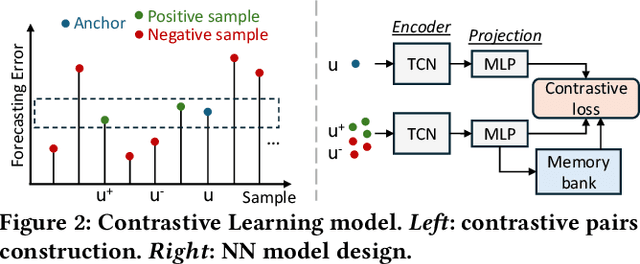
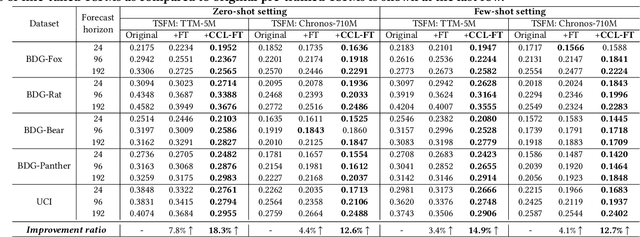
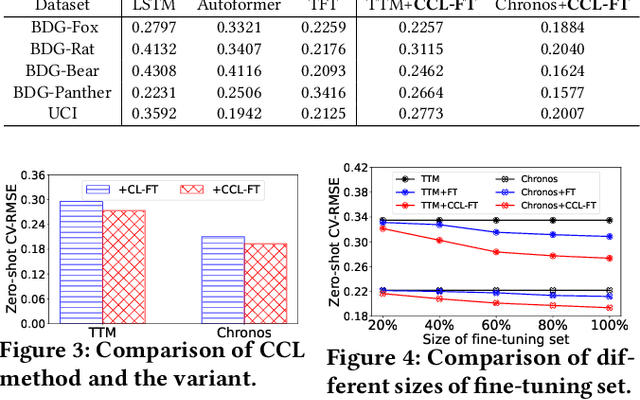
Abstract:Advances in time-series forecasting are driving a shift from conventional machine learning models to foundation models (FMs) that are trained with generalized knowledge. However, existing FMs still perform poorly in the energy fields, such as building energy forecasting (BEF). This paper studies the adaptation of FM to BEF tasks. We demonstrate the shortcomings of fine-tuning FM straightforwardly from both the perspectives of FM and the data. To overcome these limitations, we propose a new \textit{contrastive curriculum learning}-based training method. Our method optimizes the ordering of training data in the context of TSFM adaptation. Experiments show that our method can improve the zero/few-shot performance by 14.6\% compared to the existing FMs. Our code and new TSFM will be available at <Anonymous Github Repo>.
Mitigating Degree Bias in Signed Graph Neural Networks
Aug 16, 2024Abstract:Like Graph Neural Networks (GNNs), Signed Graph Neural Networks (SGNNs) are also up against fairness issues from source data and typical aggregation method. In this paper, we are pioneering to make the investigation of fairness in SGNNs expanded from GNNs. We identify the issue of degree bias within signed graphs, offering a new perspective on the fairness issues related to SGNNs. To handle the confronted bias issue, inspired by previous work on degree bias, a new Model-Agnostic method is consequently proposed to enhance representation of nodes with different degrees, which named as Degree Debiased Signed Graph Neural Network (DD-SGNN) . More specifically, in each layer, we make a transfer from nodes with high degree to nodes with low degree inside a head-to-tail triplet, which to supplement the underlying domain missing structure of the tail nodes and meanwhile maintain the positive and negative semantics specified by balance theory in signed graphs. We make extensive experiments on four real-world datasets. The result verifies the validity of the model, that is, our model mitigates the degree bias issue without compromising performance($\textit{i.e.}$, AUC, F1). The code is provided in supplementary material.
Online Relocating and Matching of Ride-Hailing Services: A Model-Based Modular Approach
Oct 13, 2023



Abstract:This study proposes an innovative model-based modular approach (MMA) to dynamically optimize order matching and vehicle relocation in a ride-hailing platform. MMA utilizes a two-layer and modular modeling structure. The upper layer determines the spatial transfer patterns of vehicle flow within the system to maximize the total revenue of the current and future stages. With the guidance provided by the upper layer, the lower layer performs rapid vehicle-to-order matching and vehicle relocation. MMA is interpretable, and equipped with the customized and polynomial-time algorithm, which, as an online order-matching and vehicle-relocation algorithm, can scale past thousands of vehicles. We theoretically prove that the proposed algorithm can achieve the global optimum in stylized networks, while the numerical experiments based on both the toy network and realistic dataset demonstrate that MMA is capable of achieving superior systematic performance compared to batch matching and reinforcement-learning based methods. Moreover, its modular and lightweight modeling structure further enables it to achieve a high level of robustness against demand variation while maintaining a relatively low computational cost.
Vehicle Dispatching and Routing of On-Demand Intercity Ride-Pooling Services: A Multi-Agent Hierarchical Reinforcement Learning Approach
Jul 13, 2023Abstract:The integrated development of city clusters has given rise to an increasing demand for intercity travel. Intercity ride-pooling service exhibits considerable potential in upgrading traditional intercity bus services by implementing demand-responsive enhancements. Nevertheless, its online operations suffer the inherent complexities due to the coupling of vehicle resource allocation among cities and pooled-ride vehicle routing. To tackle these challenges, this study proposes a two-level framework designed to facilitate online fleet management. Specifically, a novel multi-agent feudal reinforcement learning model is proposed at the upper level of the framework to cooperatively assign idle vehicles to different intercity lines, while the lower level updates the routes of vehicles using an adaptive large neighborhood search heuristic. Numerical studies based on the realistic dataset of Xiamen and its surrounding cities in China show that the proposed framework effectively mitigates the supply and demand imbalances, and achieves significant improvement in both the average daily system profit and order fulfillment ratio.
Data-driven Method for Estimating Aircraft Mass from Quick Access Recorder using Aircraft Dynamics and Multilayer Perceptron Neural Network
Dec 10, 2020

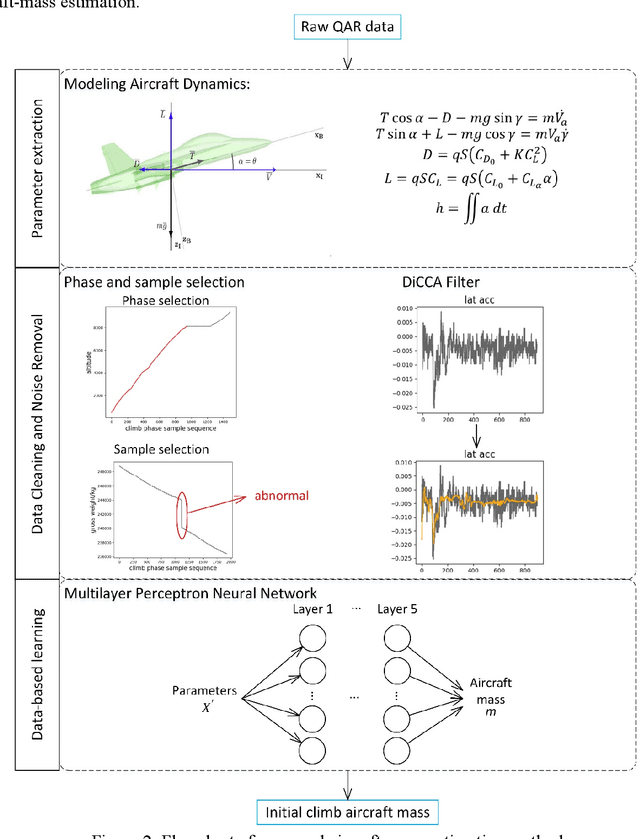
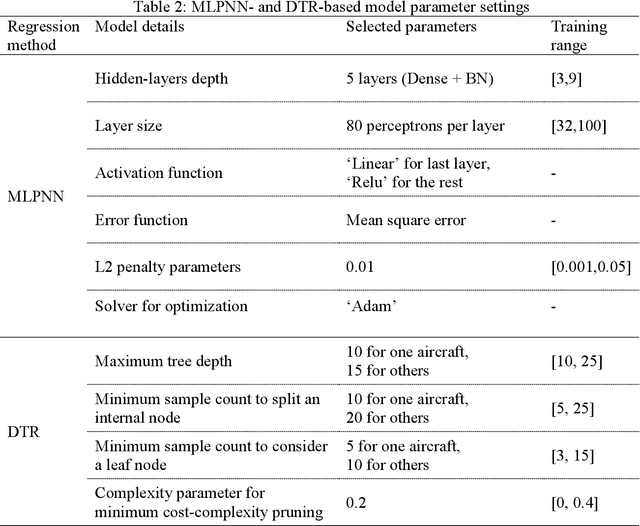
Abstract:Accurate aircraft-mass estimation is critical to airlines from the safety-management and performance-optimization viewpoints. Overloading an aircraft with passengers and baggage might result in a safety hazard. In contrast, not fully utilizing an aircraft's payload-carrying capacity undermines its operational efficiency and airline profitability. However, accurate determination of the aircraft mass for each operating flight is not feasible because it is impractical to weigh each aircraft component, including the payload. The existing methods for aircraft-mass estimation are dependent on the aircraft- and engine-performance parameters, which are usually considered proprietary information. Moreover, the values of these parameters vary under different operating conditions while those of others might be subject to large estimation errors. This paper presents a data-driven method involving use of the quick access recorder (QAR)-a digital flight-data recorder-installed on all aircrafts to record the initial aircraft climb mass during each flight. The method requires users to select appropriate parameters among several thousand others recorded by the QAR using physical models. The selected data are subsequently processed and provided as input to a multilayer perceptron neural network for building the model for initial-climb aircraft-mass prediction. Thus, the proposed method offers the advantages of both the model-based and data-driven approaches for aircraft-mass estimation. Because this method does not explicitly rely on any aircraft or engine parameter, it is universally applicable to all aircraft types. In this study, the proposed method was applied to a set of Boeing 777-300ER aircrafts, the results of which demonstrated reasonable accuracy. Airlines can use this tool to better utilize aircraft's payload.
Multi-Vehicle Routing Problems with Soft Time Windows: A Multi-Agent Reinforcement Learning Approach
Feb 13, 2020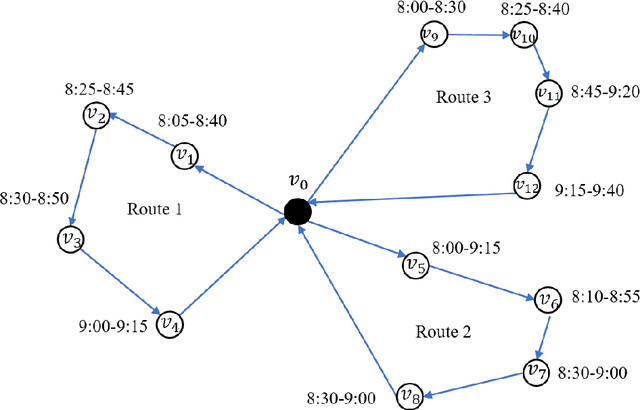
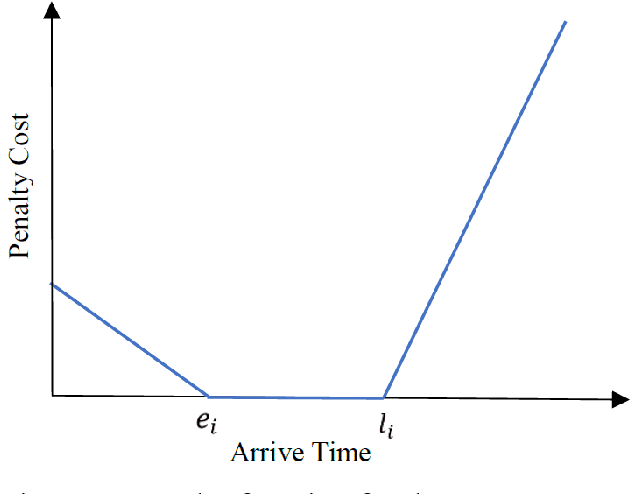
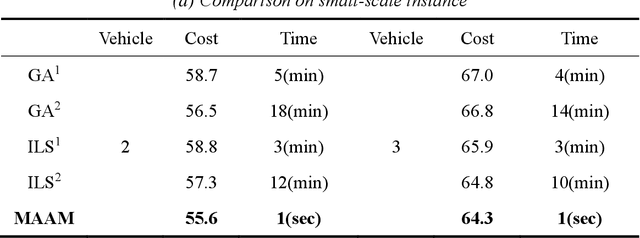
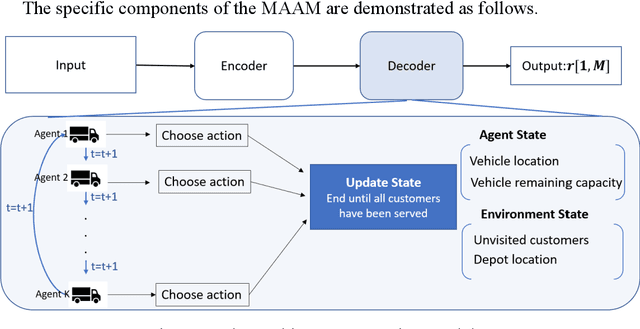
Abstract:Multi-vehicle routing problem with soft time windows (MVRPSTW) is an indispensable constituent in urban logistics distribution system. In the last decade, numerous methods for MVRPSTW have sprung up, but most of them are based on heuristic rules which require huge computation time. With the rapid increasing of logistics demand, traditional methods incur the dilemma of computation efficiency. To efficiently solve the problem, we propose a novel reinforcement learning algorithm named Multi-Agent Attention Model in this paper. Specifically, the vehicle routing problem is regarded as a vehicle tour generation process, and an encoder-decoder framework with attention layers is proposed to generate tours of multiple vehicles iteratively. Furthermore, a multi-agent reinforcement learning method with an unsupervised auxiliary network is developed for model training. By evaluated on three synthetic networks with different scale, the results demonstrate that the proposed method consistently outperforms traditional methods with little computation time. In addition, we validate the extensibility of the well-trained model by varying the number of customers and capacity of vehicles. Finally, the impact of parameters settings on the algorithmic performance are investigated.
Feature Learning Viewpoint of AdaBoost and a New Algorithm
Apr 08, 2019
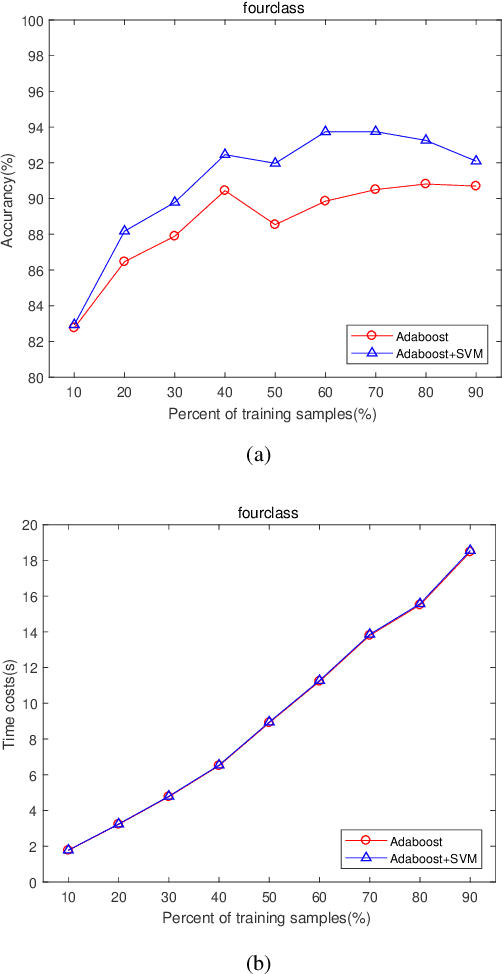
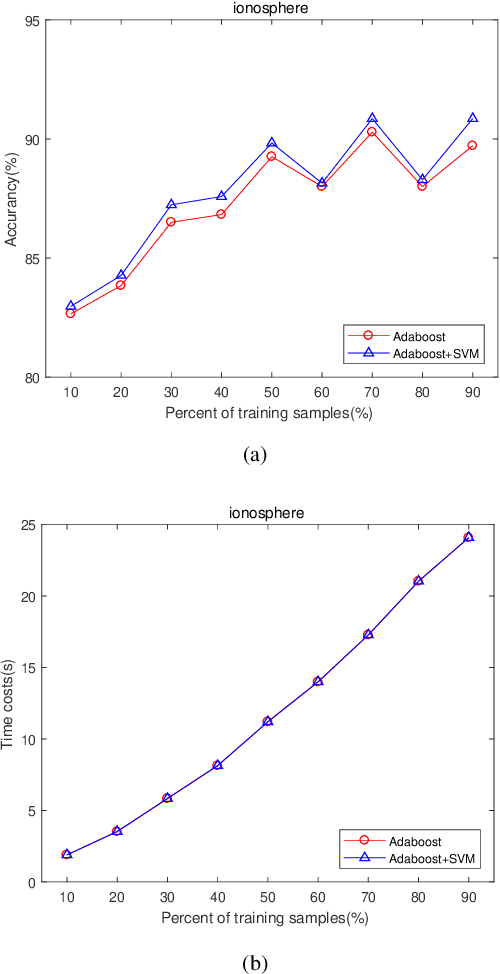
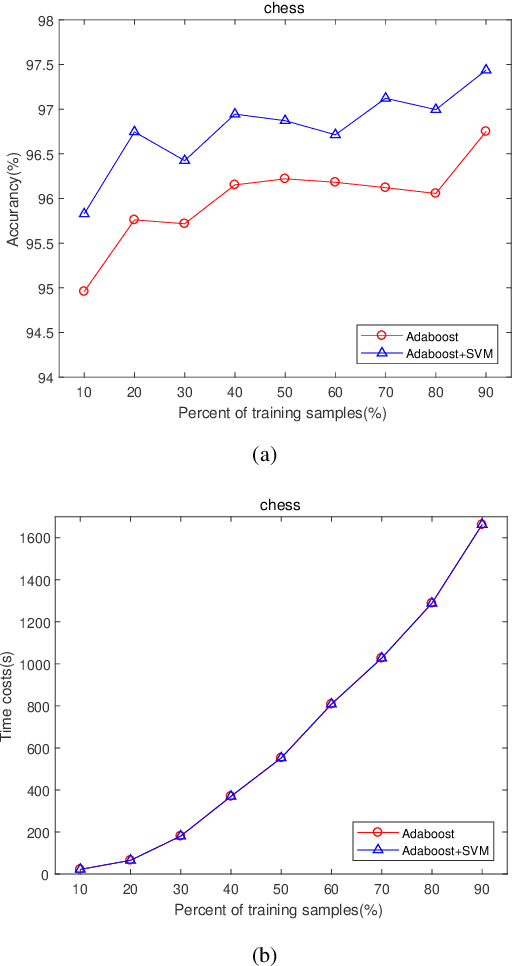
Abstract:The AdaBoost algorithm has the superiority of resisting overfitting. Understanding the mysteries of this phenomena is a very fascinating fundamental theoretical problem. Many studies are devoted to explaining it from statistical view and margin theory. In this paper, we illustrate it from feature learning viewpoint, and propose the AdaBoost+SVM algorithm, which can explain the resistant to overfitting of AdaBoost directly and easily to understand. Firstly, we adopt the AdaBoost algorithm to learn the base classifiers. Then, instead of directly weighted combination the base classifiers, we regard them as features and input them to SVM classifier. With this, the new coefficient and bias can be obtained, which can be used to construct the final classifier. We explain the rationality of this and illustrate the theorem that when the dimension of these features increases, the performance of SVM would not be worse, which can explain the resistant to overfitting of AdaBoost.
 Add to Chrome
Add to Chrome Add to Firefox
Add to Firefox Add to Edge
Add to Edge